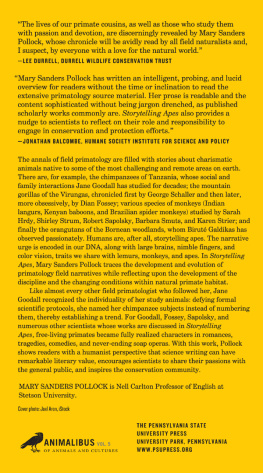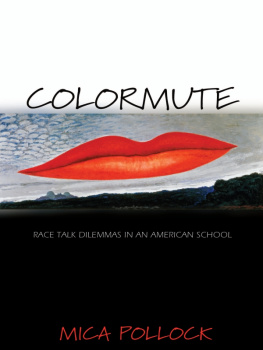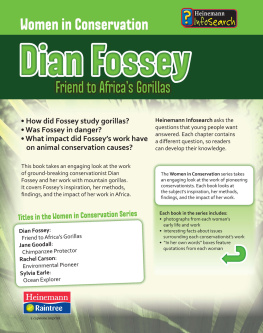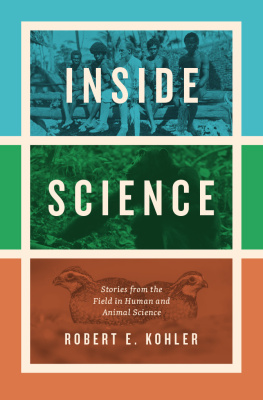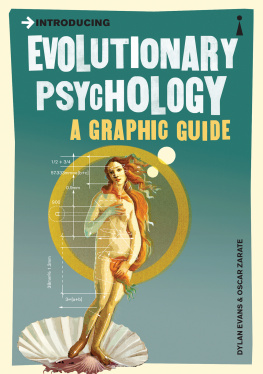STORYTELLING APES

Nigel Rothfels and Garry Marvin, General Editors
ADVISORY BOARD:
Steve Baker (University of Central Lancashire)
Susan McHugh (University of New England)
Jules Pretty (University of Essex)
Alan Rauch (University of North Carolina at Charlotte)
Books in the Animalibus series share a fascination with the status and the role of animals in human life. Crossing the humanities and the social sciences to include work in history, anthropology, social and cultural geography, environmental studies, and literary and art criticism, these books ask what thinking about nonhuman animals can teach us about human cultures, about what it means to be human, and about how that meaning might shift across times and places.
OTHER TITLES IN THE SERIES:
Rachel Poliquin,
The Breathless Zoo: Taxidermy and the Cultures of Longing
Joan B. Landes, Paula Young Lee, and Paul Youngquist, eds.,
Gorgeous Beasts: Animal Bodies in Historical Perspective
Liv Emma Thorsen, Karen A. Rader, and Adam Dodd, eds.,
Animals on Display: The Creaturely in Museums, Zoos, and Natural History
Ann-Janine Morey,
Picturing Dogs, Seeing Ourselves: Vintage American Photographs

Library of Congress Cataloging-in-Publication Data
Pollock, Mary Sanders, 1948, author.
Storytelling apes : primatology narratives past and future / Mary Sanders Pollock.
pages cm (Animalibus)
Summary: A literary analysis of the popular genre of the informal primatology field narrative. Explores the works of Jane Goodall, Dian Fossey, Robert Sapolsky, and others in the contexts of scientific, literary, and conservation discoursesProvided by publisher.
Includes bibliographical references and index.
ISBN 978-0-271-06630-1 (cloth : alk. paper)
1. PrimatologyAuthorship.
2. PrimatologyFieldwork.
3. Creative nonfictionHistory and criticism.
I. Title. II. Series: Animalibus.
QL 737. P 9 P 643 2015
599.8dc23
2014043060
Copyright 2015 The Pennsylvania State University
All rights reserved
Printed in the United States of America
Published by The Pennsylvania State University Press,
University Park, PA 168021003
The Pennsylvania State University Press is a member of the Association of American University Presses.
It is the policy of The Pennsylvania State University Press to use acid-free paper. Publications on uncoated stock satisfy the minimum requirements of American National Standard for Information SciencesPermanence of Paper for Printed Library Material, ANSI Z 39.481992.
FOR MY BROTHERS,
John, Tom, and Jim,
and
IN MEMORY OF
Ann Elizabeth Burlin
CONTENTS
Like most other primates, we humans form social groups for safety, comfort, and fun. This book is the result of such a groupinga fission-fusion group of friends and fellows. Without them, you would not be reading these stories.
After a campus visit by Jane Goodall, the late president of Stetson University, H. Douglas Lee, urged me to focus my animal studies research on primates. Soon after, I participated in a workshop at the National Humanities Centerand came away confident that I could do that. I am grateful to everyone at the NHC. I could not have continued without the help, conversations, and tolerance of my friends in the American Society of Primatologists, especially Evan Zucker and Karen Bales. At Stetson University, Dean Grady Ballenger and the many members of the Professional Development Committee over the years have generously supported this project with grant funding and sabbatical leave.
For reading and responding when I asked, I am deeply grateful to my department chairs Tom Farrell and John Pearson and to my colleagues Terry Farrell and Emily Mieras. Librarians Cathy Ervin and Susan Derryberry provided material support, Terry Grieb provided technical support, and Cathy Burkes help was essential in preparing this book for publication. Michelle Bezanson has contributed the wonderful line drawings at the beginning of each chapter; as well as anyone possibly could, she understands the borderland where art and science meet.
Without the support of Catherine Rainwater, Carrie Rohman, Karla Armbruster, and Sarah McFarland, I might have given up. The late Ann Burlin helped and encouraged me along the way. Thanks also to Patti Ragan at the Center for Great Apes. Rick Mueller, Nancy Vosburg, Ellen Phillips, Clifford Endres, Yves Clemmen, John Sanders, Tom Sanders, Marianne Sanders, and Vivian Sanders helped in many ways. Maggie the dog was supportive in her own way.
Without help from some of the scientists about whom I have written, I could not have completed this project. I am deeply grateful to Karen Strier for her advice and encouragement. Barbara Smuts and Robert Sapolsky responded generously to my requests for information and photographs. Lorna Joachim and Monica Mogilewsky opened their field sites and their hearts. I am grateful to Kendra Boileau and Julie Schoelles at Penn State University Press for understanding and honoring my intentions. I thank you all.

We can no longer speak of reality... without considering how the world is altered and created when it is put into words.
WALLACE MARTIN , Recent Theories of Narrative
I
I begin this story with a glance at some small monkeys in a small place and a scientist who loves them. The monkeys and the scientist are exemplary.
I look up from the treacherous clay path just as a toucan hops, high in the canopy, from one branch to another, its black silhouette and magnificent yellow beak clearly visible even from my position. Are you sure it wasnt a monkey? asks Lorna Joachim. When theyre going short distances, toucans sometimes hop like monkeys instead of flying. Almost as if invoked by our longing, monkey shapes now emerge from the leafy shadows, a hundred feet above our heads. They could be spider monkeys, capuchins, or howlersthree species who share this small forest fragment in northeast Costa Rica. Almost at once, Lorna identifies the shapes as mantled black howler monkeys, who are apparently deciding whether to travel on after napping or lunching.
Lorna sees monkeys in trees because she has a search pattern for the monkeys, consisting of type and speed of movement, size, coloration, location, and the company they keep. For this species, noise is the best identifying feature, but howlers howl only on their own schedules, or if they are protesting someones presence. Since following howlers means constantly looking up through backlit branches, the slow, deliberate hopping movements of the monkeys are the first thing that can be spotted from the ground. Howlers are much heavier than the capuchins who also inhabit this area, and less agile than the resident spider monkeys, so they move more slowly. If the light is just right, an observer can see the males fluffy white scrotal fur, and if the silhouette can be distinguished clearly from the background, head and body shape are also identifying features. Finally, these howlers typically live and travel in groups of fewer than ten. Their lives are so completely arboreal that, without the search pattern, the follower probably wont see the monkeys at all in their natural habitat.

